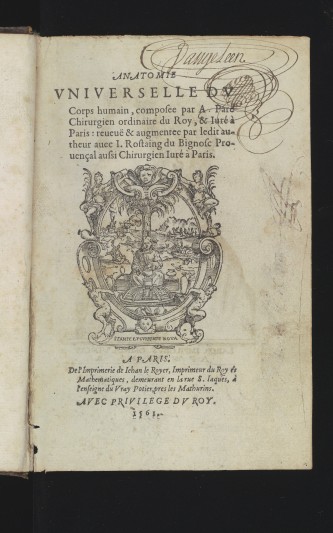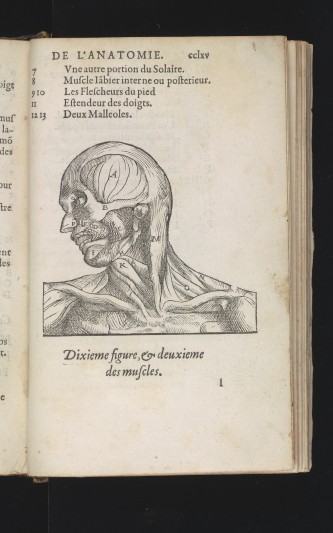Cambridge University Library is very grateful for the grant from the Friends of the National Libraries which enabled us to acquire this very rare illustrated anatomy by the French royal surgeon Ambroise Paré (1510?–1590). The Anatomie universelle is a much enlarged edition of Paré’s earlier Briefve collection de l’administration anatomique (Paris, 1549) and illustrated for the first time with one engraving of Paré and 49 woodcuts—the anatomical ones according to Vesalius, the surgical ones of Paré’s own devising. Paré was surgeon to Henry II, Francis II, Charles IX and Henry III and his writings were influential across Europe. He is remembered primarily for his contributions to surgery, and regarded knowledge of anatomy to be of paramount importance for its practice. The Anatomie universelle filled the need for an affordable manual in the vernacular at a time when most anatomies were either still in Latin or too expensive for barber surgeons.
This acquisition complements the Library’s outstanding holdings of illustrated anatomies, many from the collection of the distinguished surgeon and scholar Sir Geoffrey Keynes (1887–1982). Keynes assembled a fine library of early anatomy books, including copies of Paré’s collected works. He also published an edition of The apologie and treatise of Ambroise Paré (1951) and wrote an article on Paré for Scientific American in 1956. The Library also holds six works by Paré in the collection of Bishop John Moore (1646–1714), whose 30,000 books and manuscripts reflect the breadth of his interests, above all in medicine. Finally, the Anatomie universelle also complements the 16th-century French works in the Montaigne Library of Gilbert de Botton, held at Cambridge. Paré and Montaigne both wrote on the topic of ‘monsters and prodigies’ and Montaigne may have drawn on Paré’s work for his comments on old age in ‘Of repentance’ in his Essais.
This copy bears an early ownership inscription (‘Vaugeleen’?) and was later in the collection of the doctor and poet François Moutier (1881–1961), testimony to the long tradition of doctors and surgeons collecting Paré’s works (William Hunter and William Osler, as well as Geoffrey Keynes, are other examples). The book is therefore also of note for the history of collecting, but its primary research value clearly lies in the history of anatomy and anatomical illustration. It will be of great use to students and researchers at Cambridge, where this is an active area of interest, as well as to visiting scholars, and will support many lines of inquiry.
The book will be fully digitised for the Cambridge Digital Library, making it freely accessible to a global audience, and was exhibited at the Library in January 2018, along with a selection of illustrated anatomical books from Sir Geoffrey Keynes collection.

